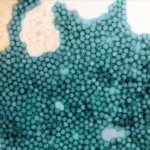Lien vers Pubmed [PMID] – 16504332
Virus Res. 2006 Sep;120(1-2):79-90
The genus Flavivirus, family Flaviviridae, comprises more than 70 viruses. Many of them cause severe, potentially fatal, human diseases. Human vaccines are available for only three viruses and no effective antiviral drug is available. In order to limit the consequences of infections with flaviviruses, a promising approach consists in developing specific compounds that target the virus-encoded NS2B/NS3 protease complex, which is crucial for the viral polyprotein processing. In order to develop such compounds active as antiviral drugs against several flaviviruses, identification of biochemical properties shared by proteases from different viruses is essential. In this work, the functional similarity between the proteases from seven flaviviruses belonging to different major groups was addressed by characterizing their enzymatic properties. For each virus, a catalytically active recombinant protease was designed and expressed as a hexahistidine-tagged protein. Chromogenic and fluorogenic substrates were used to identify optimal conditions for proteolysis. Our study identified important physico-chemical properties shared by all the seven proteases we studied (high pH value requirement for optimal activity, inhibition of substrate processing by salt). However, it also evidenced slight differences in biochemical properties of the flaviviral proteases, which could sustain heterogeneous sensitivity to future inhibitors.

